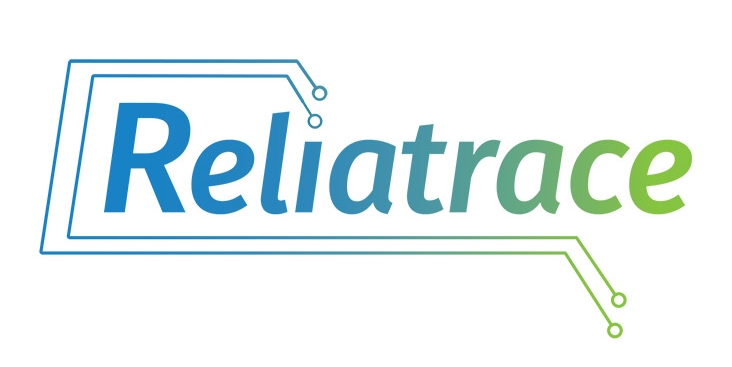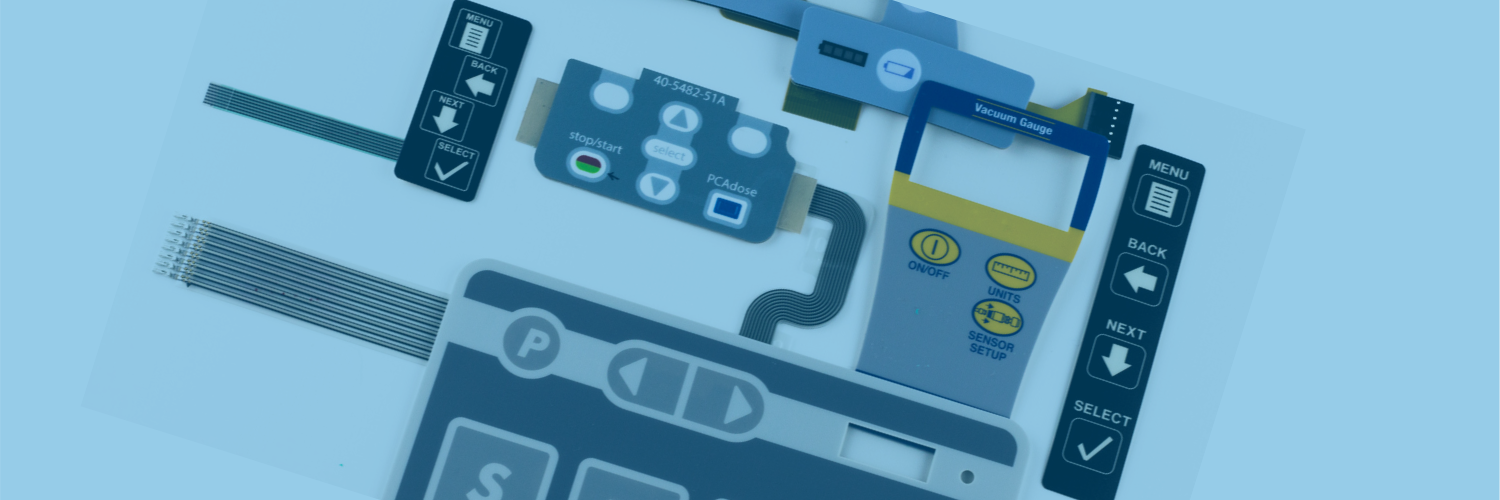MEMBRANE SWITCH design GUIDE
Designing a double-sided Reliaswitch® membrane switch means designing for reliability. Whether you’re a medical device engineer looking to redesign a single-sided membrane switch that failed, an R&D engineer developing an innovative application, or the maker of rugged outdoor machinery that needs a harsh environment solution, this guide is for you.
Often, the membrane switch is one of the last components engineers account for in the overall design of their medical device or other high-performance application. At Reliatrace®, we encourage engineers to think about the membrane switch much earlier in the device design process. When Reliatrace collaborates with the engineering team prior to the completion of the enclosure, the enhanced reliability features include:
Lower stack-up height. Prevent the membrane switch from exceeding the enclosure height, where it could collect more dirt and debris.
Smaller circuitry footprint. D/SPC enables a smaller footprint OR added functionality (e.g., higher-density keypad positions, increased number of SMT components) in your existing real estate.
Single tail trace connector. Single-sided competitors are often forced to design two tail trace connectors to meet design requirements, which introduces significant risk of trace fracture into your design. Reliaswitch technology allows you to design for only ONE tail trace connector, enabling tail traces to be in compression rather than expansion.
For more detail on how to design exceptional reliability into your membrane switch, continue reading our Design Guide, or contact Reliatrace for a design discussion. Your custom Reliaswitch technology includes many of the same design options as a single-sided membrane switch, which are outlined in Part 1. Additionally, our proprietary Double-Sided Polymer Circuitry (D/SPC®) technology allows us to offer additional design options not possible in single-sided designs, which are outlined in Part 2.
Part 1: Standard Membrane Switch Design Options
Types of Membrane Switches
Reliaswitch is available as either a tactile or non-tactile membrane switch, depending on the primary use and purpose of your application.
Tactile
Reliatrace offers a wide range of both stainless steel and polyester domes to provide tactile feedback. High-quality metal snap domes are recommended for most applications, which give more solid tactile feedback, and provide higher reliability in the extreme temperature ranges of harsh environments. Stainless steel domes are available in a wide range of options, with sizes ranging from 4mm to 25mm, and a variety of thicknesses and actuation forces. Custom options are also available, which can be produced with minimal lead time.
While stainless steel domes require no tooling, polyester domes are manufactured on a single sheet and require embossing, making them more cost-effective only for high-volume applications. More ideal for room temperature environments, polyester domes are more likely to crack in the cold, or erroneously activate all switches when they soften and “go flat” in hot temperatures.
Non-tactile
Non-tactile membrane switches are typically used when low cost is the primary driver of design considerations. Although this type of membrane switch is rated for higher actuations, it lacks the physical “snap” feedback of a tactile membrane switch, requiring the incorporation of sound or visual cues to indicate activation.
Actuation Force
Reliaswitch can be designed to any custom actuation force or switch travel, depending on your design requirements. While Reliatrace can accommodate any specifications requested, typical actuation forces (tactile) range from 3 to 25 oz., with needs that vary by application:
Light force for smaller, denser keypads
Medium force for most applications, including medical device or beverage dispensing
Heavy force for applications where operators may be wearing gloves, such as outdoor, construction or industrial machinery
Materials
Producing the industry’s most reliable membrane switches requires using the industry’s most reliable — yet cost-effective — materials. Many suppliers either make expensive material recommendations without considering the original equipment manufacturer (OEM) requirements, or recommend “cheap” alternatives that contribute to circuitry failure. At Reliatrace, we expertly guide you through membrane switch material selection to help achieve the best balance of cost and performance.
Substrate. The vast majority of the high-performance custom circuitry produced at Reliatrace is printed on Polyester thick film (.003” to .010”) due to its superior durability and flexibility.
Ink. Reliatrace uses high-quality silver and carbon inks to print conductive traces and UV-curable dielectric ink to insulate and protect flexible circuitry.
Adhesives. Commonly the most expensive materials in a membrane switch, it’s critical to work with a supplier that can help you understand what trade-offs you can and cannot make when selecting pressure sensitive adhesives (PSAs). With 30 years of experience using 3M™’s industry-leading technologies, Reliatrace will expertly guide your PSA selection, accounting for a multitude of factors that impact both your budgetary and quality requirements, including:
Indoor vs. outdoor application
Harshness of the environment (exposure to hot / cold temperatures, rain, dirt, etc.)
Surface energy (LSE vs. HSE)
Material type (metal, plastic, textured)
Heat, chemical or humidity resistance
Thickness / stack-up height limitations
Graphic Overlay
Digitally-printed in our Class 100,000 Clean Room, your Reliaswitch graphic overlay is manufactured in a controlled environment where the adverse effects of small particles such as dust and airborne microbes are significantly reduced. With the color variability of screen printing eliminated, consistent color matching is possible for any standard or system your design requires.
Compared to screen-printed overlays, digital-printing produces 20%-30% less material waste and uses more eco-friendly inks, making this printing process more cost-effective and environmentally friendly. Ideal for companies printing membrane switches for global or multilingual audiences, digital printing is Unicode™-enabled and can accurately print international characters of varying widths.
Design options for your graphic overlay include:
Substrate: Given its flexibility, high durability, long life cycle and chemical resistance properties, polyester is the most commonly used and preferred substrate for graphic overlays, particularly for environments where harsh cleaning agents or chemicals are frequently used. Reliatrace may recommend an alternative substrate material for specific types of end-uses (e.g., poly-carbonate for low-frequency devices), and has the ability to utilize any substrate commercially available.
Hard coating: Reliaswitch graphic overlays are available in a variety of hard coat options to match your end-use requirements:
Textured (non-glossy): indoor use where the appearance of fingerprints needs to be minimized, available in matte or velvet.
Glossy: improves scratch-resistance and reduces glare for bright-light applications; especially important when your design includes a clear window.
UV: outdoor use where protection against sunlight exposure is necessary to prevent “yellowing”.
Silicone rubber keypad. If preferred, Reliaswitch can be manufactured with a silicone rubber keypad, custom-built for your interface.
Embossing
The key areas of your graphic overlay can be accentuated with embossing, which creates a raised surface and can be one of three main types:
Rim (i.e., perimeter). Allows the user to more easily locate the key by raising just the frame of an area.
Pillow (i.e., pad). The pillow raises the entire key and will rest over a metal or polyester dome, providing positive tactile feedback. Keys can be embossed in a variety of shapes (e.g., rounded, square, concave/convex, etc.), edges (sharp or round) and styles (emboss or deboss). It is also possible to customize with drafted sidewalls, recesses, contours, multiple shapes and multiple levels.
Light-Emitting Diode (LED) / Bulb. Embossing may also be done to raise LEDs above the surface of an overlay, when the LED is incorporated into the package. This provides a wider viewing angle than a typical flat overlay window.
On other areas of your graphic overlay, aesthetic enhancements such as decorative logos, characters or symbols can also be embossed, as can Braille.
An alternative to embossing is hydro forming (i.e., tactile embossed graphics), which involve the formation of a tactile dome in the graphic layer to create a raised, tactile feel. This is a more costly alternative that involves tooling and longer setup/cycle times.
Interconnect / Connection Types
Reliatrace has the ability to meet most standard interconnect requirements, with tooling for Nicomatic, crimp, or solder connections that conform to AMP or Berg connecting specifications. Connectors can also be designed to interface with a ZIF (Zero Insertion Force) connector.
Mechanical Tolerances
To fabricate the various layers of your membrane switch, Reliatrace uses steel rule dies with the following tolerances:
Standard: +/- .015”
Critical dimensions (e.g. perimeter or cutouts): +/- .010”
Hole center to hole center: +/- .005”
Circuit layers underneath the graphic overlay will be fabricated at a smaller size, typically .015” inset from the graphic overlay at all edges and cutouts.
For applications requiring tighter tolerances than steel rule die can accommodate, Reliatrace offers hard tooling or laser cutting:
Hard Tool Thin Plate Die:
Height: better than +/- .001”
X/Y Size: better than .002”
Laser Cutting:
Typically .002” (note: lasers produce a debris vapor that requires cut membrane switch layers to be cleaned prior to assembly — an important step many competitors fail to account for in their manufacturing process)
Part 2: D/SPC Membrane Switch Design Options
Electrical Layout
Most of our competitors will claim the more freedom you give them to design your pinout / keypad, the more efficient your layout will be.
That’s not how we do things at Reliatrace.
With our D/SPC technology, YOU get the freedom. Because we can print traces on both the top and bottom of the substrate, you get the freedom to design your membrane switch with more reliability, more functionality, more space in the x-y plane, and more flexibility where you need it most. For a detailed explanation of how our proprietary technology works, please click here.
For your pinout, whether you choose a Common Bus or Matrix layout, our double-sided technology provides you with enhanced capabilities. The below image features two examples of membrane switch pinout schematics, which are not optimized for reliability or efficiency due to their single-sided design.
The Common Bus layout on the left requires that each trace be isolated, which on a single-sided circuit, limits the number of keypad positions that can be designed into a circuit layout and requires a large number of leads. If more keypad positions or functionality are required, single-sided layouts force you to either increase circuit size — impossible if your enclosure can’t be expanded — or use a Matrix layout, like the one on the right. While the use of the full X-Y plane in this design allows you to employ fewer leads to produce a higher number of connections, it has a dangerous draw-back. These single-sided matrix layouts require the use of cross-over, bridged or jumper connections — inherent points of weakness that are prone to silver migration and commonly cause circuitry failure.
In the functional keypad example below, Reliatrace eliminated these points of weakness by redesigning the single-sided layout (left) into a Reliaswitch circuit, utilizing D/SPC technology (right). An inherently more reliable circuit, silver cannot migrate through the substrate in the Reliaswitch design.
Powered by our D/SPC technology and 30 years of industry experience, our engineers can help you convert almost any single-sided membrane switch layout into a more reliable double-sided design. In addition to making your membrane switch more reliable, D/SPC also gives you more efficient and flexible design options in your electrical layout, including:
Denser Packaging. D/SPC enables more design space and higher interconnect density for added performance and functionality, such as a larger number of keypad positions, more SMT components or a wider outer perimeter for shielding and gasketing.
Smaller circuitry footprint. Compared to single-sided designs, D/SPC uses less space in the X-Y plane to run circuit traces. When your membrane switch is designed during the early stages of overall application design, you may be able to make a smaller, lighter device at a lower cost.
Eliminate dual-circuit/tail layers joined in a connector. When challenged to add more functionality or features to a membrane switch, single-sided technology designs commonly require both a top and bottom circuitry layer, joined together in a connector. Not only are two-circuit designs utilizing single-sided technology less reliable, they also require additional material and are more costly to produce than Reliaswitch. In most cases, Reliaswitch requires only one, double-sided circuitry layer, eliminating this problem and resulting in increased reliability, reduced material costs and lower stack-up height.
Tail Exit
One of the most prevalent causes of circuitry (and overall assembly) failure with single-sided membrane switches results from the creasing or bending of the tail near the exit point. In single-sided applications, the tail traces are printed on the top of the tail, a design limitation that puts the traces into expansion and significantly increases the risk of fracture. Many competitors will instruct you to exercise “extreme caution” when designing your tail exit to avoid bending, which can be very limiting in your overall application design.
Utilizing a dual circuit/tail design unnecessarily increases your risk of circuitry failure. Reliatrace®’s proprietary D/SPC® technology eliminates this risk.
Additionally, in dual-circuit/tail designs that employ two full circuitry sheets stacked on top of another, you are forced to employ two tails. When the tails are flexed, this increases the stress between the two tails and the switch body, which over time, may cause the PSA to sheer and eventually pull away. Once delamination starts, the environmental seal is lost, exposing your circuitry to moisture and chemical ingress, which ultimately results in circuitry failure.
Reliaswitch’s proprietary D/SPC technology allows you to run a single tail from the double-sided circuit, which enables ALL tail traces to be printed on the bottom side of the circuit — in compression, NOT expansion — when routing leads from the circuit level to the PCB connection inside the enclosure. This capability inherently eliminates the risk of fracture, providing you with greater flexibility in the design and location of your tail exit.
Windows
Clear windows can be used when your membrane switch has an LED or other type of display incorporated. Single-sided suppliers are forced to use cross-over circuitry and/or a dual tail design — where the traces are in expansion, increasing the risk of fracture — to route traces around the clear window(s). Not only does this introduce unnecessary risk into your design, it also increases material cost. With Reliaswitch, our ability to print traces on both sides of the substrate allows the circuitry above the window to be connected to the circuitry below the window — without the use of cross-overs or a dual-tail design — significantly increasing your reliability and cost-efficiency.
Surface-Mount Technology (SMT)
With D/SPC, you are able to employ a higher number of SMT components (e.g., LEDs or resistors), without increasing your circuitry footprint. Single-sided competitors are often forced to use a less reliable dual-circuit design to accommodate SMT requirements, increasing the stack-up height and making your membrane switch more rigid. Reliaswitch enables you to accommodate SMT requirements while keeping your membrane switch more reliable, flexible and thinner.
LED / Backlighting
Reliaswitch provides LED backlighting, which is embossed over the top of the circuit and provides a 180-degree viewing angle, which is desirable for most medical applications. Compared to single-sided circuits, Reliaswitch offers more room to place LED components.
Gasketing
When you need to seal your membrane switch for a harsh environment to protect against water or chemical ingress, gasketing is critical. With D/SPC, you have more room in your circuitry design to add an outer perimeter to increase the efficacy of your gasket. Reliaswitch is designed and manufactured to NEMA 4X / IP66 standards, providing watertight protection against moisture and dirt, as well as additional corrosion resistance (tested against ammonia, vinegar, bleach, soap water and hydrogen peroxide).
Shielding
Single-sided membrane switches are often more susceptible to electrostatic discharge (ESD), as they are forced to push traces farther into the perimeter, increasing the risk of ESD escaping outside the edge of the circuit. As D/SPC allows for traces to be printed on both sides of the circuit substrate, enabling a wider outer perimeter between the traces and the switch edge, you may be able to avoid shielding all together. With D/SPC, you can also eliminate the need for a tab or slot that connects the shield to the ground, as the shield layer can be connected to the circuit through the use of a printed thru-hole. If your membrane switch will be exposed to excessive ESD or radio frequency interference (RFI), Reliaswitch can be designed with a carbon or silver shield for extra protection.



